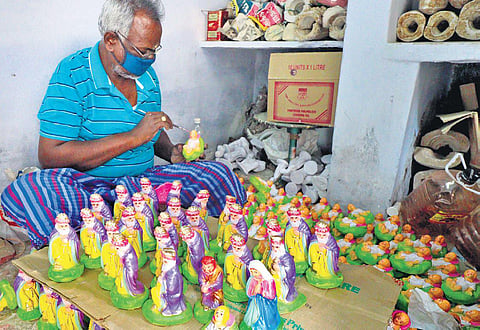

MADURAI: On the outskirts of Madurai city is a crib where the ‘elves’ are currently at work making figures of Mary, Joseph, Baby Jesus, shepherds, angels and cattle to deliver before Christmas. The 300 families of Vilachery have a production hall each at their homes where they mould and paint these figurines. But what makes these artisans stand out from the rest? It is their unique moulds.
“Each family has its own mould inspired by ancient paintings and statues. The designers also keep improvising and embrace new technology,” said M Ramalingam, advisor for Kullalar Handicraft Artisan Welfare Association. In recognition of their exclusivity, the Ministry of Micro, Small and Medium Enterprises sanctioned Rs.6 crore to Vilachery recently to set up a community production unit.
The Kullalar Handicraft Artisan Welfare Association has also applied for a geographical indication (GI) tag for their clay toys. Ramalingam urged the government to set up a craft village where production and sales units can operate under one roof. It would also help in promoting tourism, he said.
Though the families also make dolls for Navaratri and Vinayakar Chaturthi, Christmas crib dolls are their main source of income. The rural households were once producing earthenware. In the early 1960s when Chithira Kala Studio, the first studio in Madurai, was set up, artisans were needed for making cinema sets. “The villagers, who are mostly from the Kullalar community, were taken for work to the studio,” Ramalingam said.
“The studio was later moved to Chennai. In 1965, Sadhasivam Velar and Sooran Velar, who settled in Vilachery, started a clay doll-making unit. The villagers, who earlier worked in the studio, joined the unit and learned the craft. Over a period, they started their own units,” he added.
M Senthil Kumar (40), who has been in the business for 20 years, said, “The clay is taken from nearby tanks. However, in recent times, materials such as plaster of paris and papier-mâché are being used to make dolls. Though the production cost has increased, we could not increase the price. We have to compromise on profit to keep the business going,” he said.
The wholesale doll market is completely dependent on traders from Kerala. Then came the cyclone and floods that devastated Kerala. When we were slowly recovering, we were hit by the pandemic. After a long battle, the business has started picking up pace for this Christmas as lockdown restrictions have been relaxed,” said S Kavitha (38).
The restriction on importing Chinese dolls, which posed a stiff competition, has come as a blessing. “We reduced production this year and capped the price range from Rs 150-3,000. The demand was high enough to sell most of the manufactured products,” the villagers said.